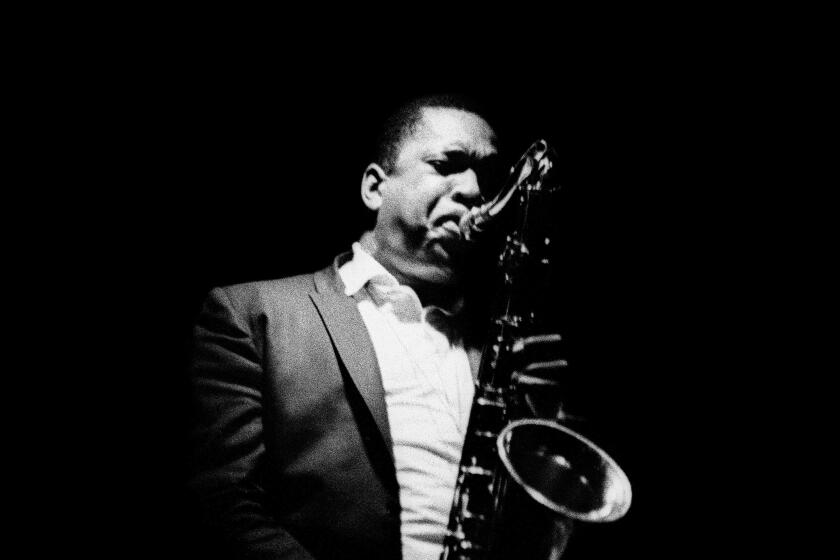Hammer Museum a Low-Profile Affair
- Share via
Opinions vary about Armand Hammer’s plan to build his own museum instead of giving his collections to the County Museum of Art, but one thing seems certain. The busiest corner of Westwood will have a new look and a fresh cultural identity with the appearance of the Armand Hammer Museum of Art and Cultural Center.
New York architect Edward Larrabee Barnes’ proposed museum--to be constructed adjacent to the Kirkeby Building--is a low-profile affair. Rising only two stories (50 feet) above ground and encapsulated in an elegant but plain skin of Carrara marble, it will probably offend no one. The museum is certain to be more attractive than the existing parking structure, surface-level lot and service station that presently occupy the block bordered by Wilshire, Westwood, Glendon Avenue and Lindbrook Drive.
Barnes unveiled a model for the 79,000-square-foot building at a recent press conference called to announce Hammer’s astonishing plans. The architect introduced “a simple building” whose walls “follow the direction of the streets, like so many buildings in Europe” where plain exteriors often conceal central courtyards. The museum’s open-air court will be “a quiet oasis”--a retreat from urban noise and congestion, according to the architect.
Though the court will have no permanent roof, “protective sails” can be drawn across it for shelter from inclement weather, Barnes said, placing folded strips on top of the model.
He has designed a “limousine drive-through” from Westwood Boulevard to Glendon Avenue and pedestrian access through an iron gate on Lindbrook Drive.
Suave and smiling, Barnes gave members of the press a quick rundown of the building’s features. The first floor of the structure will contain a scholarly library, a 250-seat auditorium, a restaurant, administrative offices and study centers including one for Hammer’s vast collection of material by French satirist Honore Daumier.
A book and gift store will extend to the second floor. The remainder of the second story will display selections from Hammer’s three collections: a cache of about 60 Old Master and Impressionist paintings called “Five Centuries of Art”; the Armand Hammer Daumier Collection, consisting of 10,000 lithographs, paintings, drawings and sculptures, and the “Codex Hammer,” a 36-sheet manuscript by Leonardo da Vinci containing scientific drawings and mirror (backwards) writing by the Italian Renaissance master.
Barnes said the galleries will be “tailored to the exact requirements of the art.” He called his plan “a house museum, more like a home than a museum.”
“Everything that a modern museum has, we expect to have,” said Hammer, when asked about facilities, staff and programs.
Parking, a crucial issue in Westwood, will be handled by five underground levels, according to the plan. Asked how many more parking spaces would be added to the volume presently provided, Hammer said “a lot” but that he didn’t know an exact number.
While the building is under construction he said employees of the Kirkeby Building will park in a lot several blocks away and take a shuttle bus to the building.
The project must pass a “rigorous review” and conform to Westwood’s master plan, according to City Councilman Zev Yaroslavsky.
“It will take six months before we can even break ground and another 2 1/2 years to build. We expect the museum to open in the fall of 1990,” said Hammer, who will be 92 when that happens.
Barnes is well known as a museum architect. Among his completed projects are the Walker Art Center in Minneapolis, the Dallas Museum of Art, the Asia Society in New York and IBM’s art gallery and headquarters, also in Manhattan.
In developing the Hammer museum, Barnes will work with John Walker, the director emeritus and former chief curator of the National Gallery in Washington, D.C., who has helped Hammer shape his art collection.
Obviously pleased to bring a museum into his district, Yaroslavsky said he expects the Hammer center to be “one of the most attractive small museums in the country, if not the world.”
Walker, who appears to be a stranger to Los Angeles’ car-oriented life style, praised Hammer for deciding to put a museum in Westwood “where it is needed.” After all, he said, “it’s a long way to go (from Westwood) to the County Museum of Art.”
More to Read
The biggest entertainment stories
Get our big stories about Hollywood, film, television, music, arts, culture and more right in your inbox as soon as they publish.
You may occasionally receive promotional content from the Los Angeles Times.










